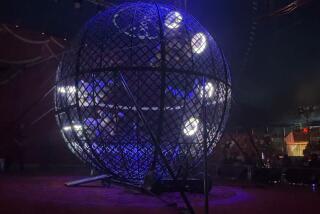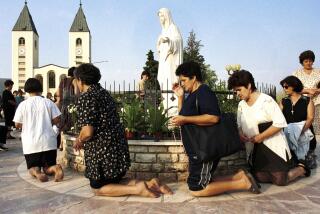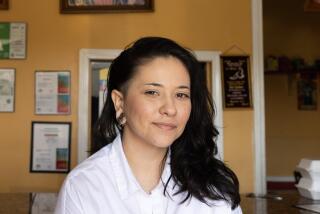RELIGION / JOHN DART : Keeping a Traditionalist Faith : <i> Dominus vobiscum et cum spiritu tuo</i> . --An oft-repeated blessing (“The Lord be with you and with your Spirit”) by the priest in the old Latin Mass
- Share via
The Mass in English and other modern languages has been the Roman Catholic norm for about a quarter-century now, but the old Latin liturgy still reverberates through three chapel-like settings in Los Angeles’ northern reaches.
Small numbers of dedicated Catholics step back in time--to before the reform-minded Second Vatican Council (1962-65) encouraged the use of the vernacular and authorized a revised Mass that has the priest face the congregation and involves more lay participation.
At the San Fernando Rey Mission, the so-called Tridentine Mass is celebrated at noon on the first Sunday of every month except September. On other Sundays in the archdiocese, the rite is scheduled in turn at chapels in Duarte, Santa Paula, Santa Barbara and Los Angeles.
Those rites are archdiocesan-sponsored and Vatican-sanctioned.
Not so the Tridentine Masses regularly celebrated in Canoga Park and at a new location in Santa Clarita. Led by priests outside the Roman church’s authority, they tend to attract Catholics who thought the Vatican drifted fatally into error with the changes introduced in the 1960s.
The Roman Catholic hierarchy has intermittently skirmished with the traditionalist, sometimes schismatic, wings of the church, most notably in 1988 when Rome excommunicated dissident Archbishop Marcel Lefebvre, now deceased. For the most part, however, the official church ignores various movements that hang on, often meeting in temporary quarters and keeping alive what they are convinced is immutable tradition and an unsullied respect for the holy.
An estimated 250 to 300 believers fill one building at the Chapel in the Canyon in Canoga Park for the 8:30 a.m. Mass celebrated each Sunday by Father Frederick Schell, who declined to be interviewed by The Times. The traditionalist Catholic group is one of three congregations using the interdenominational Chapel in the Canyon, which is best known as a wedding site with its four chapels and garden area.
Another traditionalist group recently took a step toward permanence by purchasing for $250,000 a small church building on Newhall Avenue across the street from William S. Hart County Park. The 7-year-old Queen of the Angels congregation, which met for several years in a rented Granada Hills chapel, held its first Mass in Santa Clarita on June 6 in the wood-frame building once occupied by a Church of Christ congregation.
The nine rows of wooden pews hold close to 100 people, said Father Dominick Radecki, 35. He celebrates two Masses on Sunday morning and said he will soon add a Sunday evening Mass. About 170 people attended Mass last Sunday, coming from as far away as San Diego, Riverside and the Antelope Valley, he said.
Radecki pointed to the statues of Mary and Joseph on either side of the altar and, under the central cross, the tabernacle holding the elements of Communion.
“In conciliar churches today the tabernacle is usually off to the side,” Radecki said, referring to the Catholic Church of the post-Second Vatican Council era. “God was once above us. Now God comes down and man is raised up.”
In a booklet given to newcomers, worshipers are requested to dress modestly--women in sleeved blouses and hemlines below the knee and men with buttoned shirts and no jeans. An usher will provide a “loaner” head covering for women who come without a veil or scarf.
The soft-spoken Radecki, eager to press the case of the traditionalist movement, characterizes the Mass at most Catholic parishes today as “social gatherings” with forced gaiety and a lost sense of the sacred.
Radecki was ordained in 1987 with his twin brother, who lives in Michigan, at Mt. St. Michael Seminary in Spokane, Wash., by the Congregation of Mary Immaculate Queen. The movement has only 13 ordained clergy.
The Radecki family was involved in a series of controversies surrounding the movement’s founder, layman-turned-bishop Francis Schuckardt. Henry Radecki, Dominick’s father, sued Schuckardt in Toledo, Ohio, for alienating the affections of his family, but an appellate court reversed the judgment in 1976 on religious liberty grounds, holding that “in the absence of improper motives, a religious sect has a lawful right to solicit members and to express views relevant thereto.” The Santa Clarita priest said that his father, who stayed loyal to the establishment Catholic Church, and his mother eventually divorced.
Schuckardt was later sued for breaking up a marriage by an Idaho man, but that favorable ruling for the plaintiff also failed on appeal. By 1984, however, Schuckardt was confronted from within his movement on charges of drug abuse and immorality, and he left the group. Despite the leadership crisis, Radecki said, the group is the second-largest U.S. traditionalist body after the Lefebvre-founded Society of St. Pius X.
In a conciliatory move by the Vatican, Pope John Paul II decreed in 1984 that dioceses could permit the celebration of the older Latin Mass. It was stipulated, however, that neither priests nor participants should have ties with those who impugn the lawfulness or doctrinal soundness of the revised Mass.
To Radecki and a Queen of Angels parishioner, Dick Jamison of Reseda, the papal-approved Mass is traditional liturgy yoked to a deviant theology.
“If I follow a Pope who teaches heresy, I am in danger of hell,” said Jamison, 50, an ex-actor and marketing consultant.
Nevertheless, the San Fernando Rey Mission gets a steady turnout of about 200 Catholics at the monthly Latin Mass celebrated by Msgr. Francis J. Weber. (The mission once was the site of a Tridentine Mass every fifth Sunday when that occurred, but no longer, Weber said.)
“I think there is room in the church for all these flavors of liturgy,” Weber said. “I also think some people learn it is hard to follow when you weren’t raised in it.”
The Mass at the mission is enhanced by the singing of a 25-voice choir from St. John the Baptist de la Salle parish in Granada Hills led by music director Geraldine Biggs McGrath. That parish, with Father Michael Slattery as pastor, is one of the few in the archdiocese that regularly schedules the Latin version of the revised Mass--at 10:30 a.m. every third Sunday.
“We sing the Gregorian chant, but the congregation sings along with us,” McGrath said.
“It’s really a lovely experience--it takes me back to my childhood,” McGrath said, speaking of both the old and the new Mass in Latin. “It’s nice for the people who miss the sound of the Latin, and it keeps us in touch with the universal church.” She noted that the Pope celebrates the Mass in Latin every day.
More to Read
Sign up for Essential California
The most important California stories and recommendations in your inbox every morning.
You may occasionally receive promotional content from the Los Angeles Times.










